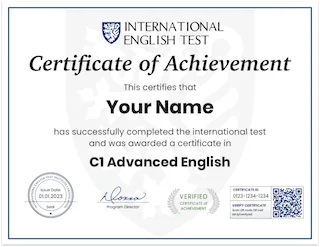Read expert guidance on crafting engaging essays, mastering structure and creating impactful introductions.
In this extensive guide, we will guide you through the intricacies of essay writing in English. We’ll delve into the fundamentals of essay structure, provide insights into crafting engaging introductions, developing robust body paragraphs, constructing compelling conclusions, and refining your essays through the editing process. By the end of this article, you’ll have the knowledge to write an essay in English that captivates readers, conveys your ideas effectively, and makes a lasting impact.
What is your English level?
Find out your A1 A2 B1 B2 C1 C2 level of English with our online test and receive your English certificate.
Guide on essay writing
An essay is a written piece that articulates and defends a specific idea, argument, or perspective. It serves as a means to convey thoughts, share information, and convince others of a particular viewpoint. Essays can take on different forms, including argumentative, persuasive, expository, and descriptive, each fulfilling a distinct purpose.
The key components of an essay
An essay is comparable to a journey, guiding the reader from one point to another through your words and ideas. To ensure a seamless experience, let’s dissect the five essential components of an essay:
Introduction
The essay’s beginning, where you introduce the topic and capture the reader’s attention.
Thesis statement
A brief statement articulating your main argument or viewpoint, typically located at the conclusion of the introduction.
Body paragraphs
The core of your essay, where you expand on your primary points and furnish supporting evidence.
Conclusion
The concluding part where you recapitulate your main points, restate your thesis, and leave the reader with something to contemplate.
Getting ready for effective essay writing
Before immersing yourself in the realm of words and ideas, it’s crucial to arm yourself with the appropriate tools and strategies. Just as an experienced traveler meticulously plans before a journey, successful essay writing demands thorough preparation to guarantee a seamless and rewarding experience. This segment examines the fundamental steps that establish the foundation for creating compelling essays.
Choosing a suitable topic
Before you commence your essay-writing expedition, opt for a topic that captures your interest and aligns with the essay’s purpose. A thoughtfully selected topic enhances the writing process, making it more enjoyable and allowing your enthusiasm to illuminate your words.
Brainstorming methods
Brainstorming serves as the catalyst for creativity. Record all the ideas associated with your selected topic that come to mind. Don’t concern yourself with organizing them at this stage; the objective is to generate a reservoir of potential ideas to utilize.
Researching and refining ideas
After compiling a list of ideas, the next step involves research. Seek out reliable sources that offer valuable insights into your topic. As you collect information, begin the process of refining your focus to emphasize the most compelling and relevant aspects.
Conducting comprehensive research
Efficient research forms the foundation of a finely tuned essay. Utilize online databases, books, academic journals, and reputable websites to amass diverse information. It’s crucial to take meticulous notes for seamless referencing in later stages.
Utilizing trustworthy sources and proper references
Maintaining credibility is paramount in essay writing. Ensure the sources you use are reliable and esteemed within the academic community. When integrating information from these sources, be diligent in providing accurate citations and references to prevent plagiarism.
Strategies for effective note-taking
Establish a note-taking system that suits your preferences, whether through handwritten notes, digital documents, or a combination. It’s crucial to maintain organized, clear, and easily accessible notes to facilitate the writing process.
Are you C1 Advanced English?
Get your C1 Advanced English certificate now!
✓ Add your certificate to your resume
⭐ ⭐ ⭐ ⭐ ⭐
Crafting an engaging introduction
Crafting a captivating introduction is vital in essay writing, as it sets the tone for the entire piece. This section will guide you on creating introductions that not only capture attention but also ignite curiosity, inviting readers to delve deeper into your essay.
Capturing the reader’s attention
Consider your introduction as the entrance to your essay. Capture your reader’s interest with an intriguing opening sentence that sparks curiosity and compels them to read on.
For instance, if you were crafting an essay about Mary Jackson, the first Black woman to work at NASA, you might introduce it this way:
“Picture an era when reaching for the stars meant challenging more than just gravity. Mary Jackson, a remarkable mathematician and engineer, accomplished precisely that. In a world where opportunities for Black women were constrained, she became the pioneer in shattering barriers at NASA.”
- Anecdotes or quotes
- Presenting a thought-provoking question
Writing a compelling thesis statement
At the heart of every well-crafted essay is a guiding force – a thesis statement that illuminates the trajectory your arguments will follow. Your thesis statement serves as the pivotal point that binds your essay, offering direction and purpose to every word you pen.
Continuing with our essay example on Mary Jackson, our thesis statement might be articulated as follows:
“This essay delves into the life of Mary Jackson, highlighting her pioneering spirit, unwavering determination, and enduring impact on science and society. Through the exploration of her journey, you will witness how her legacy serves as an ongoing inspiration for generations, affirming that, even in the face of adversity, dreams have the power to soar higher than the sky.”
- Clarity and specificity
- Signposting the essay’s main points

Developing strong body paragraphs
Creating robust body paragraphs is akin to constructing chambers where your ideas flourish, come to life, and interlace to form a compelling narrative. A proficient writer adeptly shapes body paragraphs that progressively build upon each other, resulting in a coherent and persuasive argument. This section will delve into the craft of developing powerful body paragraphs characterized by organization, informativeness, and seamless transitions.
Organizing ideas coherently
Dedicate each body paragraph to a singular main idea or argument, ensuring a logical sequence that builds upon the preceding one.
- Utilizing topic sentences
- Logical flow of information
Supporting arguments with evidence
Reinforce your assertions with evidence, including statistics, facts, examples, and expert opinions, to enhance the credibility and persuasiveness of your arguments.
- Incorporating quotations and examples
- Proper citation and referencing

Mastering essay structure and coherence
The elegance of a captivating essay is found in the richness of its content and the smooth progression of its ideas. This section will elucidate how to enhance your comprehension of essay structure and coherence, exploring techniques that transform paragraphs into a well-organized and engaging piece of writing.
Creating a compelling conclusion
The essay’s conclusion goes beyond being a mere summary; it is a contemplative reflection that resonates with the core of your arguments, weaving them into a gratifying unity. This segment will delve into the craft of constructing a compelling conclusion, emphasizing the reiteration of main points while introducing a new perspective, a thought-provoking insight, or a call to action.
Summarizing the key points
In the conclusion, succinctly recap the primary points addressed in your essay, serving as a reminder of the journey you guided your reader through.
- Reiterating the thesis statement
- Briefly summarizing the main arguments
Providing a thought-provoking closing section
Conclude your essay by offering your reader a concluding thought, question, or idea that prompts reflection on the topic and its broader implications.
- Implications or future considerations
- Leaving a lasting impression on the reader

Polishing your essay: The editing process
During the editing process, your essay evolves from a preliminary draft into a refined masterpiece, poised to captivate its audience. In this segment, we will delve into the intricacies of the editing phase, exploring methods to scrutinize grammar, punctuation, style, and clarity in your essay. From employing proofreading techniques to leveraging grammar-checking tools, we will outline the steps to elevate your essay’s precision and eloquence.
Reviewing grammar and punctuation
Before submitting your essay, meticulously examine it for grammatical errors, punctuation mistakes, and spelling issues.
- Proofreading techniques
- Utilizing grammar-checking tools
Enhancing clarity and style
Ensure that your sentences are clear and concise, avoiding overly complex language or jargon that might confuse your reader.
- Sentence structure and variety
- Removing unnecessary jargon
What is your English level?
Find out your A1 A2 B1 B2 C1 C2 level of English with our online test and receive your English certificate.
Showcasing your unique voice
In a world brimming with words, your voice serves as the distinctive signature that sets your essay apart. Each writer possesses a unique voice that injects personality and authenticity into their work. Striking a balance between objectivity and subjectivity and incorporating personal insights will guide you in crafting a composition that resonates with your individuality. As you undertake the journey to discover and amplify your voice, recognize that your words bear the imprint of your identity, enriching your essay with depth and resonance.
Infusing your personal perspective
Feel encouraged to incorporate relevant insights and personal experiences into your essay, as it enhances relatability and connection with your readers.
- Balancing objectivity and subjectivity
- Expressing individual insights

Overcoming writer’s block
Writer’s block, a common hurdle on the creative journey, is a challenge faced by all writers. Overcoming it involves various strategies, such as freewriting and establishing a consistent writing routine. It’s crucial to recognize that even accomplished writers encounter resistance, and the key is their skill in overcoming it.
Techniques to overcome writing challenges
Writer’s block is unpredictable, but trying out various methods like freewriting and mind mapping can help overcome creative obstacles.
Freewriting and mind mapping
Participate in freewriting by setting a timer and expressing your thoughts without concern for grammar or structure. Alternatively, utilize mind maps to visually organize your ideas.
Taking breaks and seeking inspiration
Step away from your writing and do something else when you’re stuck. A change of scenery or a brisk walk can help refresh your mind.
Building a writing routine
Developing a regular writing routine can boost motivation and facilitate steady progress in your essay-writing endeavors.
- Setting goals and deadlines
- Finding your optimal writing environment

Conclusion
In this exploration of the craft of essay writing in English, you’ve acquired the skills to create an essay that engages, informs, and persuades. Every aspect, from choosing a topic to crafting a compelling conclusion, contributes to the overall excellence of your essay.
Essay writing is more than just a skill; it’s a potent tool that has the capacity to shape opinions, influence decisions, and foster connections across cultures and time zones.
What is your English level?
Find out your A1 A2 B1 B2 C1 C2 level of English with our online test and receive your English certificate.
I am Nilay, an experienced English Language Assessment Director at the International English Test, where I have been working full-time since February 2020. I specialize in helping people worldwide validate their English proficiency through comprehensive assessments and certifications.
Before joining the International English Test, I worked as a self-employed English Language Assessment Consultant from January 2015 to December 2019. During this time, I assisted companies and individuals in improving their language skills, helping them achieve their academic and professional goals.
I hold a degree in Engineering and have also studied at Shafston International College in Australia. My educational background has equipped me with the tools to make a meaningful impact in the field of English language learning. Additionally, I enjoy sharing my expertise through articles that explore effective teaching methods and language assessment strategies, contributing to the International English Test and the broader assessment community.





